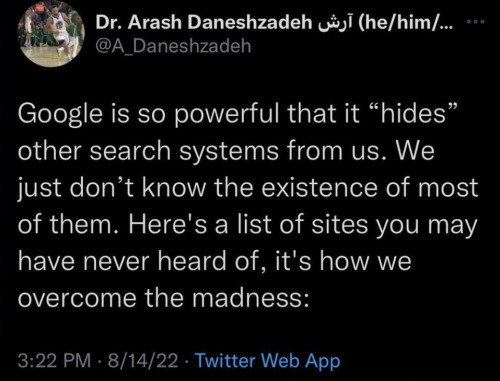So You Need To Buy A Computer But You Don't Know What Specs Are Good These Days
So You Need To Buy A Computer But You Don't Know What Specs Are Good These Days
Hi.
This is literally my job.
Lots of people are buying computers for school right now or are replacing computers as their five-year-old college laptop craps out so here's the standard specs you should be looking for in a (windows) computer purchase in August 2023.
PROCESSOR
Intel i5 (no older than 10th Gen)
Ryzen 7
You can get away with a Ryzen 5 but an intel i3 should be an absolute last resort. You want at least an intel i5 or a Ryzen 7 processor. The current generation of intel processors is 13, but anything 10 or newer is perfectly fine. DO NOT get a higher performance line with an older generation; a 13th gen i5 is better than an 8th gen i7. (Unfortunately I don't know enough about ryzens to tell you which generation is the earliest you should get, but staying within 3 generations is a good rule of thumb)
RAM
8GB absolute minimum
If you don't have at least 8GB RAM on a modern computer it's going to be very, very slow. Ideally you want a computer with at least 16GB, and it's a good idea to get a computer that will let you add or swap RAM down the line (nearly all desktops will let you do this, for laptops you need to check the specs for Memory and see how many slots there are and how many slots are available; laptops with soldered RAM cannot have the memory upgraded - this is common in very slim laptops)
STORAGE
256GB SSD
Computers mostly come with SSDs these days; SSDs are faster than HDDs but typically have lower storage for the same price. That being said: SSDs are coming down in price and if you're installing your own drive you can easily upgrade the size for a low cost. Unfortunately that doesn't do anything for you for the initial purchase.
A lot of cheaper laptops will have a 128GB SSD and, because a lot of stuff is stored in the cloud these days, that can be functional. I still recommend getting a bit more storage than that because it's nice if you can store your music and documents and photos on your device instead of on the cloud. You want to be able to access your files even if you don't have internet access.
But don't get a computer with a big HDD instead of getting a computer with a small SSD. The difference in speed is noticeable.
SCREEN (laptop specific)
Personally I find that touchscreens have a negative impact on battery life and are easier to fuck up than standard screens. They are also harder to replace if they get broken. I do not recommend getting a touch screen unless you absolutely have to.
A lot of college students especially tend to look for the biggest laptop screen possible; don't do that. It's a pain in the ass to carry a 17" laptop around campus and with the way that everything is so thin these days it's easier to damage a 17" screen than a 14" screen.
On the other end of that: laptops with 13" screens tend to be very slim devices that are glued shut and impossible to work on or upgrade.
Your best bet (for both functionality and price) is either a 14" or a 15.6" screen. If you absolutely positively need to have a 10-key keyboard on your laptop, get the 15.6". If you need something portable more than you need 10-key, get a 14"
FORM FACTOR (desktop specific)
If you purchase an all-in-one desktop computer I will begin manifesting in your house physically. All-in-ones take away every advantage desktops have in terms of upgradeability and maintenance; they are expensive and difficult to repair and usually not worth the cost of disassembling to upgrade.
There are about four standard sizes of desktop PC: All-in-One (the size of a monitor with no other footprint), Tower (Big! probably at least two feet long in two directions), Small Form Factor Tower (Very moderate - about the size of a large shoebox), and Mini/Micro/Tiny (Small! about the size of a small hardcover book).
If you are concerned about space you are much better off getting a MicroPC and a bracket to put it on your monitor than you are getting an all-in-one. This will be about a million percent easier to work on than an all-in-one and this way if your monitor dies your computer is still functional.
Small form factor towers and towers are the easiest to work on and upgrade; if you need a burly graphics card you need to get a full size tower, but for everything else a small form factor tower will be fine. Most of our business sales are SFF towers and MicroPCs, the only time we get something larger is if we have to put a $700 graphics card in it. SFF towers will accept small graphics cards and can handle upgrades to the power supply; MicroPCs can only have the RAM and SSD upgraded and don't have room for any other components or their own internal power supply.
WARRANTY
Most desktops come with either a 1 or 3 year warranty; either of these is fine and if you want to upgrade a 1 year to a 3 year that is also fine. I've generally found that if something is going to do a warranty failure on desktop it's going to do it the first year, so you don't get a hell of a lot of added mileage out of an extended warranty but it doesn't hurt and sometimes pays off to do a 3-year.
Laptops are a different story. Laptops mostly come with a 1-year warranty and what I recommend everyone does for every laptop that will allow it is to upgrade that to the longest warranty you can get with added drop/damage protection. The most common question our customers have about laptops is if we can replace a screen and the answer is usually "yes, but it's going to be expensive." If you're purchasing a low-end laptop, the parts and labor for replacing a screen can easily cost more than half the price of a new laptop. HOWEVER, the way that most screens get broken is by getting dropped. So if you have a warranty with drop protection, you just send that sucker back to the factory and they fix it for you.
So, if it is at all possible, check if the manufacturer of a laptop you're looking at has a warranty option with drop protection. Then, within 30 days (though ideally on the first day you get it) of owning your laptop, go to the manufacturer site, register your serial number, and upgrade the warranty. If you can't afford a 3-year upgrade at once set a reminder for yourself to annually renew. But get that drop protection, especially if you are a college student or if you've got kids.
And never, ever put pens or pencils on your laptop keyboard. I've seen people ruin thousand dollar, brand-new laptops that they can't afford to fix because they closed the screen on a ten cent pencil. Keep liquids away from them too.
LIFESPAN
There's a reasonable chance that any computer you buy today will still be able to turn on and run a program or two in ten years. That does not mean that it is "functional."
At my office we estimate that the functional lifespan of desktops is 5-7 years and the functional lifespan of laptops is 3-5 years. Laptops get more wear and tear than desktops and desktops are easier to upgrade to keep them running. At 5 years for desktops and 3 years for laptops you should look at upgrading the RAM in the device and possibly consider replacing the SSD with a new (possibly larger) model, because SSDs and HDDs don't last forever.
COST
This means that you should think of your computers as an annual investment rather than as a one-time purchase. It is more worthwhile to pay $700 for a laptop that will work well for five years than it is to pay $300 for a laptop that will be outdated and slow in one year (which is what will happen if you get an 8th gen i3 with 8GB RAM). If you are going to get a $300 laptop try to get specs as close as possible to the minimums I've laid out here.
If you have to compromise on these specs, the one that is least fixable is the processor. If you get a laptop with an i3 processor you aren't going to be able to upgrade it even if you can add more RAM or a bigger SSD. If you have to get lower specs in order to afford the device put your money into the processor and make sure that the computer has available slots for upgrade and that neither the RAM nor the SSD is soldered to the motherboard. (one easy way to check this is to search "[computer model] RAM upgrade" on youtube and see if anyone has made a video showing what the inside of the laptop looks like and how much effort it takes to replace parts)
Computers are expensive right now. This is frustrating, because historically consumer computer prices have been on a downward trend but since 2020 that trend has been all over the place. Desktop computers are quite expensive at the moment (August 2023) and decent laptops are extremely variably priced.
If you are looking for a decent, upgradeable laptop that will last you a few years, here are a couple of options that you can purchase in August 2023 that have good prices for their specs:
14" Lenovo - $670 - 11th-gen i5, 16GB RAM, and 512GB SSD
15.6" HP - $540 - 11th-gen i5, 16GB RAM, and 256GB SSD
14" Dell - $710 - 12th-gen i5, 16GB RAM, and 256GB SSD
If you are looking for a decent, affordable desktop that will last you a few years, here are a couple of options that you can purchase in August 2023 that have good prices for their specs:
SFF HP - $620 - 10th-gen i5, 16GB RAM, 1TB SSD
SFF Lenovo - $560 - Ryzen 7 5000 series, 16GB RAM, 512GB SSD
Dell Tower - $800 - 10th-gen i7, 16GB RAM, 512GB SSD
If I were going to buy any of these I'd probably get the HP laptop or the Dell Tower. The HP Laptop is actually a really good price for what it is.
Anyway happy computering.
More Posts from Wierduff and Others
Every artist who sees this post should do the following:
- Watch the video.
- Follow the instructions
- Reblog
I can’t stress you enough about how important these exercises are for your drawing hand. You don’t wanna get CTS of Tendonitis and similar stuff that will prevent you from making art or even hold a pencil.
Tumblr’s search function is garbage, so if anyone needs to find specific posts it’s better to use an actual search engine and type ‘site:wastelesscrafts.tumblr.com’ with no spaces and then the thing they’re searching for. Example: ‘site:wastelesscrafts.tumblr.com buttonholes’
How to find posts
Thank you for the instructions!
Aside of using a search engine, I also have a pinned post with links to my masterposts.
I currently have eight masterposts, sorted by theme:
Sewing, mending, and crafts
Projects and patterns
My personal projects
Replies to asks (part 1)
Replies to asks (part 2)
Replies to asks (part 3)
Fast fashion and climate change
Wardrobe management etc.


refseek.com

www.worldcat.org/

link.springer.com

http://bioline.org.br/

repec.org

science.gov

pdfdrive.com
Sun Tzu is so fucking funny to me because for his time he was legitimately a brilliant tactician but a bunch of his insight is shit like "if you think you might lose, avoid doing that", "being outnumbered is bad generally", and "consider lying."


refseek.com

www.worldcat.org/

link.springer.com

http://bioline.org.br/

repec.org

science.gov

pdfdrive.com
Btw much as I love to make fun of twitter and reddit's business decisions, I have 0% trust in tumblr's management to not go a similar route so this is your gentle reminder that you should regularly go to your blog settings to export your blog. That's a fancy way of saying you can download a backup of your blog so if everything goes down you'll still have a backup of your posts & convos.
Let's talk about foreshadowing.
Foreshadowing can add a lot of depth to your writing and make it more exciting for the readers. They create a sense of coherence and satisfaction when future events unfold as hinted—or shock if they don't.
Here are some tips for effectively using foreshadowing in your novels and books:
Plan Ahead: Foreshadowing works best when it's woven into the fabric of your story from the beginning. As you outline your plot, think about key events and revelations you want to foreshadow, and strategically place hints and clues accordingly.
Use Subtlety: Foreshadowing doesn't have to be obvious or heavy-handed. The best foreshadowing is often subtle and understated, leaving readers with a sense of intrigue and curiosity rather than outright prediction.
Establish Patterns and Motifs: Look for opportunities to establish recurring patterns, motifs, or symbols that can subtly hint at future events. These can be visual, thematic, or even linguistic cues that tie into the larger narrative arc of your story.
Create Tension: Foreshadowing is most effective when it creates tension and anticipation for the reader. Use foreshadowing to hint at potential conflicts, obstacles, or twists.
Reveal Gradually: Foreshadowing doesn't have to be limited to one-off hints or clues. Instead, consider how you can layer foreshadowing throughout your story, gradually revealing more information as the plot unfolds.
Pay Attention to Timing: The timing of your foreshadowing is crucial. Introduce hints and clues at strategic points in your story, building anticipation and suspense without giving too much away too soon.
Revisit Foreshadowing: Ensure that foreshadowed events are eventually fulfilled or addressed in the story. Revisiting earlier hints or clues can provide a satisfying payoff for readers and reinforce the narrative coherence.
Balance Subtlety and Clarity: Foreshadowing should be subtle enough to intrigue readers without giving away major plot twists too early. Aim for a balance where foreshadowing is noticeable upon reflection but doesn't detract from the immediacy of the story.
Let's look at some ways to incorporate foreshadowing:
Symbolism: Symbolic imagery or motifs can serve as subtle foreshadowing devices. Think about objects, settings, or descriptive details that can serve as symbolic foreshadowing. A recurring image or object, for example, might subtly hint at future events or themes in the story.
Dialogue Clues: Characters can drop hints or make cryptic remarks that foreshadow upcoming events. Dialogue is a natural way to introduce foreshadowing without being too obvious.
Character Reactions: Pay attention to how characters react to certain situations or events. Their emotions or responses can foreshadow future conflicts or revelations.
Subtle Descriptions: Incorporate subtle descriptions or details that hint at future events. These can be easily overlooked on a first read but become significant upon reflection or when the foreshadowed event occurs.
Dreams and Visions: Dreams, visions, and other forms of altered consciousness can be effective vehicles for foreshadowing—they can hint at an upcoming event, or explore characters' subconscious desires and fears. This method can sometimes be either blatant or subtle depending on how it is incorporated.
Foreshadowing Through Setting: Use the setting to foreshadow events or developments in the story. For example, a stormy night might foreshadow conflict or turmoil ahead, while a serene setting might signal upcoming peace or resolution. (On the flip side, this can be used to catch readers off guard, like a "calm before the storm" type of situation.)
Parallel Storylines: Foreshadowing can occur through parallel storylines or subplots. Events in one storyline can subtly hint at future developments in another, creating anticipation and intrigue.
Recurring Themes: Identify recurring themes or motifs in your story and use them to foreshadow future events. These thematic elements can serve as subtle hints or clues for attentive readers.
Misdirection: Foreshadowing can be used to misdirect readers and create suspense by hinting at one outcome while actually leading to another. (See my post on misdirection for more!)
Happy writing! ❤
Dudes healthcare is so fake. My ADHD meds are $940 without insurance. But they gave me a website of "coupons" which straight up looks like a scam website, and I got it today for $60! Just a coupon from a random website and it was $900 cheaper. America, I am confusion!! America explain!!

Skip Google for Research
As Google has worked to overtake the internet, its search algorithm has not just gotten worse. It has been designed to prioritize advertisers and popular pages often times excluding pages and content that better matches your search terms
As a writer in need of information for my stories, I find this unacceptable. As a proponent of availability of information so the populace can actually educate itself, it is unforgivable.
Below is a concise list of useful research sites compiled by Edward Clark over on Facebook. I was familiar with some, but not all of these.
⁂
Google is so powerful that it “hides” other search systems from us. We just don’t know the existence of most of them. Meanwhile, there are still a huge number of excellent searchers in the world who specialize in books, science, other smart information. Keep a list of sites you never heard of.
www.refseek.com - Academic Resource Search. More than a billion sources: encyclopedia, monographies, magazines.
www.worldcat.org - a search for the contents of 20 thousand worldwide libraries. Find out where lies the nearest rare book you need.
https://link.springer.com - access to more than 10 million scientific documents: books, articles, research protocols.
www.bioline.org.br is a library of scientific bioscience journals published in developing countries.
http://repec.org - volunteers from 102 countries have collected almost 4 million publications on economics and related science.
www.science.gov is an American state search engine on 2200+ scientific sites. More than 200 million articles are indexed.
www.pdfdrive.com is the largest website for free download of books in PDF format. Claiming over 225 million names.
www.base-search.net is one of the most powerful researches on academic studies texts. More than 100 million scientific documents, 70% of them are free
-
 anime-ice-cream-boy liked this · 1 week ago
anime-ice-cream-boy liked this · 1 week ago -
 photocopyrat liked this · 1 week ago
photocopyrat liked this · 1 week ago -
 coolasakoala reblogged this · 1 week ago
coolasakoala reblogged this · 1 week ago -
 writerofblocks liked this · 2 weeks ago
writerofblocks liked this · 2 weeks ago -
 these-quiet-mornings reblogged this · 2 weeks ago
these-quiet-mornings reblogged this · 2 weeks ago -
 ranunculus-asiaticus reblogged this · 2 weeks ago
ranunculus-asiaticus reblogged this · 2 weeks ago -
 dawgsprite reblogged this · 2 weeks ago
dawgsprite reblogged this · 2 weeks ago -
 dawgsprite liked this · 2 weeks ago
dawgsprite liked this · 2 weeks ago -
 gayfrogacceptance reblogged this · 2 weeks ago
gayfrogacceptance reblogged this · 2 weeks ago -
 notreallythatactive reblogged this · 2 weeks ago
notreallythatactive reblogged this · 2 weeks ago -
 kodeless liked this · 2 weeks ago
kodeless liked this · 2 weeks ago -
 dreadmagnificence reblogged this · 2 weeks ago
dreadmagnificence reblogged this · 2 weeks ago -
 homorobouros liked this · 2 weeks ago
homorobouros liked this · 2 weeks ago -
 soapstore liked this · 3 weeks ago
soapstore liked this · 3 weeks ago -
 cocosprinkledbrownie reblogged this · 3 weeks ago
cocosprinkledbrownie reblogged this · 3 weeks ago -
 cyzyrynka reblogged this · 3 weeks ago
cyzyrynka reblogged this · 3 weeks ago -
 dirigiblefish liked this · 3 weeks ago
dirigiblefish liked this · 3 weeks ago -
 stinkymando reblogged this · 3 weeks ago
stinkymando reblogged this · 3 weeks ago -
 chrysomus liked this · 4 weeks ago
chrysomus liked this · 4 weeks ago -
 just-some-fagdyke liked this · 4 weeks ago
just-some-fagdyke liked this · 4 weeks ago -
 lilehhlilyy liked this · 4 weeks ago
lilehhlilyy liked this · 4 weeks ago -
 jeidai reblogged this · 1 month ago
jeidai reblogged this · 1 month ago -
 ozzernexus liked this · 1 month ago
ozzernexus liked this · 1 month ago -
 last-fast-naturalist liked this · 1 month ago
last-fast-naturalist liked this · 1 month ago -
 kirby-64 liked this · 1 month ago
kirby-64 liked this · 1 month ago -
 h3artbeat liked this · 1 month ago
h3artbeat liked this · 1 month ago -
 pawprintedpages liked this · 1 month ago
pawprintedpages liked this · 1 month ago -
 derflauschigstefuchs reblogged this · 1 month ago
derflauschigstefuchs reblogged this · 1 month ago -
 sneet-snart liked this · 1 month ago
sneet-snart liked this · 1 month ago -
 bobthebenevolentpirate liked this · 1 month ago
bobthebenevolentpirate liked this · 1 month ago -
 madi-konrad liked this · 1 month ago
madi-konrad liked this · 1 month ago -
 distant-snow liked this · 1 month ago
distant-snow liked this · 1 month ago -
 broothpod liked this · 1 month ago
broothpod liked this · 1 month ago -
 fairylightfairlybright liked this · 1 month ago
fairylightfairlybright liked this · 1 month ago -
 ddeacttive liked this · 1 month ago
ddeacttive liked this · 1 month ago -
 othershitineedforstuff reblogged this · 1 month ago
othershitineedforstuff reblogged this · 1 month ago -
 milkinggrrl liked this · 1 month ago
milkinggrrl liked this · 1 month ago -
 literallymyflowerr liked this · 2 months ago
literallymyflowerr liked this · 2 months ago -
 invisiblejim reblogged this · 2 months ago
invisiblejim reblogged this · 2 months ago -
 the-reynolds-pamphlet reblogged this · 2 months ago
the-reynolds-pamphlet reblogged this · 2 months ago -
 typewriteringalaxy liked this · 2 months ago
typewriteringalaxy liked this · 2 months ago -
 titleleaf liked this · 2 months ago
titleleaf liked this · 2 months ago -
 l0svers liked this · 2 months ago
l0svers liked this · 2 months ago -
 asirenbyanyothername liked this · 2 months ago
asirenbyanyothername liked this · 2 months ago -
 artsietango liked this · 2 months ago
artsietango liked this · 2 months ago -
 ghostschemes reblogged this · 2 months ago
ghostschemes reblogged this · 2 months ago -
 multimousenette liked this · 2 months ago
multimousenette liked this · 2 months ago -
 morte-darthur reblogged this · 2 months ago
morte-darthur reblogged this · 2 months ago -
 passion8alot reblogged this · 2 months ago
passion8alot reblogged this · 2 months ago
